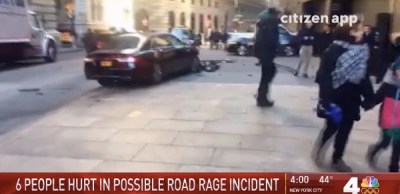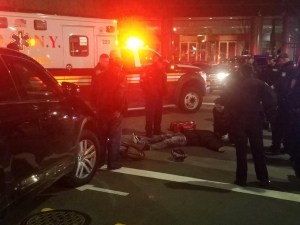No Word From TLC on Whether Cabbie Who Injured 5 and Claimed “Medical Episode” Still Drives a Cab
What is the Taxi and Limousine Commission doing to ensure that drivers with medical conditions don’t cause harm?

The Taxi and Limousine Commission is not talking about a collision between two TLC-licensed drivers that injured four bystanders in Lower Manhattan earlier this month, though one driver claimed to have a medical condition that contributed to the crash.
On December 7 a for-hire driver in a Lincoln sedan crashed into a Ford SUV affiliated with Uber on Liberty Street at Broadway. The Lincoln driver then careened down Liberty, striking a third vehicle before coming to a stop on the sidewalk.
Five people — three pedestrians, one person on a bike, and the Uber driver — were hurt. The Lincoln driver, identified by the Daily News as Gil Villamar, told police an unspecified “medical episode” caused him to crash. NYPD filed no charges.
It’s not unusual for a cab driver to blame a medical condition after a serious crash. NYPD often cites “medical episode” as a license to wreak havoc with a motor vehicle without repercussion.
But such crashes can result in criminal charges, if a driver is believed to have knowingly put others at risk by neglecting to take medication.
In November, green cab driver Emilio Garcia pled guilty to homicide for killing two people, including a 5-year-old girl, on a Bronx sidewalk after he stopped taking his epilepsy medication. Despite his condition, the TLC failed to prevent Garcia from driving a cab, even after he was involved in an earlier crash.
The Villamar crash should have triggered an inquiry into his medical history. Was he previously aware of his condition? Did he report it to the Department of Motor Vehicles and the TLC? Was he taking any required medications? It’s unknown if NYPD or the TLC pursued answers to those essential questions.
On December 13, we asked the TLC if the agency had determined whether Villamar had a medical episode, as claimed, and if his presumed condition affects his ability to safely operate a cab.
When a TLC spokesperson replied that NYPD had not yet informed the agency about the circumstances of the crash, we asked, given the possibility of another episode behind the wheel, whether the TLC debriefs drivers who cite a medical condition following a crash, rather than wait on the results of a police investigation, which can take months.
We also asked if Villamar is driving a cab while NYPD and the TLC continue to sort things out. The TLC has yet to respond.
On a separate but related note, here’s a partial list of violations attached to the Uber SUV Villamar crashed into:
- June 2016: Failure to stop at a red light, Brooklyn
- June 2016: Bus lane violation, Manhattan
- November 2016: Speeding in a school zone, Brooklyn
- December 2016: Speeding in a school zone, Bronx
- February 2017: Bike lane violation, Manhattan
- April 2017: Failure to stop at a red light, Brooklyn
- June 2017: Failure to stop at a red light, Queens
- July 2017: Speeding in a school zone, Queens
- September 2017: Speeding in a school zone, Bronx
According to Uber, the SUV is operated by more than one driver. (NYPD did not release the name of the person driving the SUV on December 7.) We asked the TLC for confirmation. If one person is responsible for those violations, we also wanted to know if that driver has ever faced TLC license sanctions.
Almost two weeks after the crash, we’re still waiting for a TLC response.

